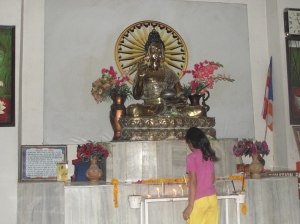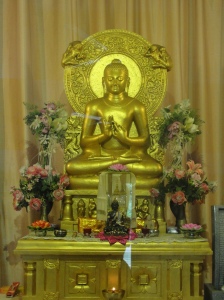The Man Who Spit In Buddha’s Face.
The Buddha was sitting under a tree talking to his disciples when a man came and spat in his face.
He wiped it off, and he asked the man, “What next? What do you want to say next?” The man was a little puzzled because he himself never expected that when you spit on somebody’s face, he will ask, “What next?” He had no such experience in his past. He had insulted people and they had become angry and they had reacted. Or if they were cowards and weaklings, they had smiled, trying to bribe the man. But Buddha was like neither, he was not angry nor in any way offended, nor in any way cowardly. But just matter-of-factly he said, “What next?” There was no reaction on his part.
But Buddha’s disciples became angry, and they reacted. His closest disciple, Ananda, said, “This is too much. We cannot tolerate it. He has to be punished for it, otherwise everybody will start doing things like this!”
Buddha said, “You keep silent. He has not offended me, but you are offending me. He is new, a stranger. He must have heard from people something about me, that this man is an atheist, a dangerous man who is throwing people off their track, a revolutionary, a corrupter. And he may have formed some idea, a notion of me. He has not spit on me, he has spit on his notion. He has spit on his idea of me because he does not know me at all, so how can he spit on me?
“If you think on it deeply,” Buddha said, “he has spit on his own mind. I am not part of it, and I can see that this poor man must have something else to say because this is a way of saying something. Spitting is a way of saying something. There are moments when you feel that language is impotent: in deep love, in intense anger, in hate, in prayer. There are intense moments when language is impotent. Then you have to do something. When you are angry, intensely angry, you hit the person, you spit on him, you are saying something. I can understand him. He must have something more to say, that’s why I’m asking, “What next?”
The man was even more puzzled! And Buddha said to his disciples, “I am more offended by you because you know me, and you have lived for years with me, and still you react.”
Puzzled, confused, the man returned home. He could not sleep the whole night. When you see a Buddha, it is difficult, impossible to sleep anymore the way you used to sleep before. Again and again he was haunted by the experience. He could not explain it to himself, what had happened. He was trembling all over, sweating and soaking the sheets. He had never come across such a man; the Buddha had shattered his whole mind and his whole pattern, his whole past.
The next morning he went back. He threw himself at Buddha’s feet. Buddha asked him again, “What next? This, too, is a way of saying something that cannot be said in language. When you come and touch my feet, you are saying something that cannot be said ordinarily, for which all words are too narrow; it cannot be contained in them.” Buddha said, “Look, Ananda, this man is again here, he is saying something. This man is a man of deep emotions.”
The man looked at Buddha and said, “Forgive me for what I did yesterday.”
Buddha said, “Forgive? But I am not the same man to whom you did it. The Ganges goes on flowing, it is never the same Ganges again. Every man is a river. The man you spit upon is no longer here. I look just like him, but I am not the same, much has happened in these twenty-four hours! The river has flowed so much. So I cannot forgive you because I have no grudge against you.
“And you also are new. I can see you are not the same man who came yesterday because that man was angry and he spit, whereas you are bowing at my feet, touching my feet. How can you be the same man? You are not the same man, so let us forget about it. Those two people, the man who spit and the man on whom he spit, both are no more. Come closer. Let us talk of something else.”
Buddha said, “You keep silent. He has not offended me, but you are offending me. He is new, a stranger. He must have heard from people something about me, that this man is an atheist, a dangerous man who is throwing people off their track, a revolutionary, a corrupter. And he may have formed some idea, a notion of me. He has not spit on me, he has spit on his notion. He has spit on his idea of me because he does not know me at all, so how can he spit on me?
“If you think on it deeply,” Buddha said, “he has spit on his own mind. I am not part of it, and I can see that this poor man must have something else to say because this is a way of saying something. Spitting is a way of saying something. There are moments when you feel that language is impotent: in deep love, in intense anger, in hate, in prayer. There are intense moments when language is impotent. Then you have to do something. When you are angry, intensely angry, you hit the person, you spit on him, you are saying something. I can understand him. He must have something more to say, that’s why I’m asking, “What next?”
The man was even more puzzled! And Buddha said to his disciples, “I am more offended by you because you know me, and you have lived for years with me, and still you react.”
Puzzled, confused, the man returned home. He could not sleep the whole night. When you see a Buddha, it is difficult, impossible to sleep anymore the way you used to sleep before. Again and again he was haunted by the experience. He could not explain it to himself, what had happened. He was trembling all over, sweating and soaking the sheets. He had never come across such a man; the Buddha had shattered his whole mind and his whole pattern, his whole past.
The next morning he went back. He threw himself at Buddha’s feet. Buddha asked him again, “What next? This, too, is a way of saying something that cannot be said in language. When you come and touch my feet, you are saying something that cannot be said ordinarily, for which all words are too narrow; it cannot be contained in them.” Buddha said, “Look, Ananda, this man is again here, he is saying something. This man is a man of deep emotions.”
The man looked at Buddha and said, “Forgive me for what I did yesterday.”
Buddha said, “Forgive? But I am not the same man to whom you did it. The Ganges goes on flowing, it is never the same Ganges again. Every man is a river. The man you spit upon is no longer here. I look just like him, but I am not the same, much has happened in these twenty-four hours! The river has flowed so much. So I cannot forgive you because I have no grudge against you.
“And you also are new. I can see you are not the same man who came yesterday because that man was angry and he spit, whereas you are bowing at my feet, touching my feet. How can you be the same man? You are not the same man, so let us forget about it. Those two people, the man who spit and the man on whom he spit, both are no more. Come closer. Let us talk of something else.”
Credit: wisdompills.com



